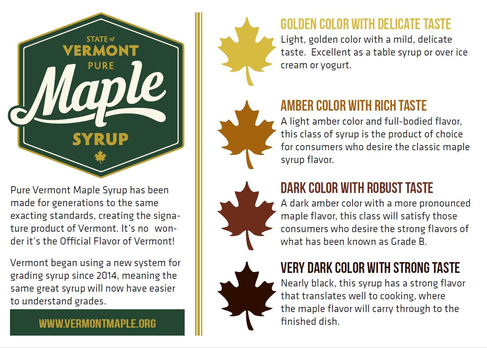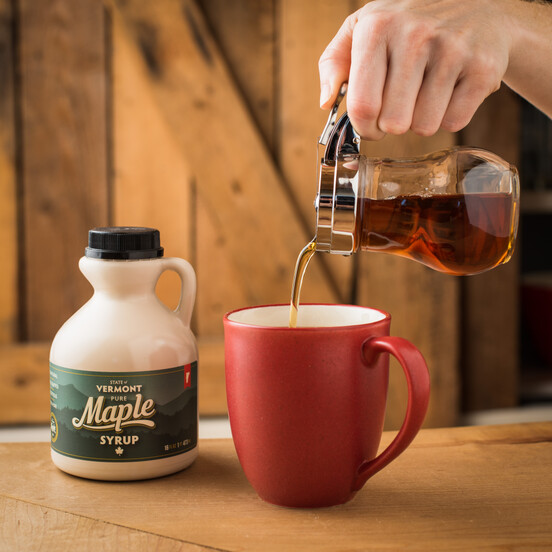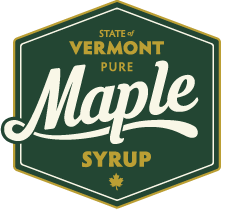Short and Sweet Facts
• It takes roughly 40 gallons of sap to make one gallon of maple syrup
• Maple sap is mostly crystal-clear water with about 2% sugar content.
• A typical sugaring season lasts 4 to 6 weeks. A pattern of freezing and thawing temperatures (below freezing at night and 40-45 degrees Fahrenheit during the day) will build up pressure within the trees causing the sap to flow from the tap holes.
• Sugaring season ends when the warmer days of late spring cause the leaf buds to unfold.
• Vermont produces roughly 50% of the United States crop. 2.22 million gallons made in 2020! A record season.
• A tree needs to be about 40 years (10-12 inches in diameter) to be large enough to tap.
• Some large maple trees in Vermont sugarbushes are over 200 years old!
• Maple syrup needs to be stored properly once it makes its way to your kitchen! See below for more.
The Best Way to Store Maple Syrup
Maple syrup, when sealed and unopened, has a long shelf life if stored in a cool, dark place. The best way to store opened maple syrup is in the refrigerator or the freezer. Sometimes the larger containers of maple syrup are a better price per ounce. Feel free to take advantage of the better price and repack the syrup in smaller containers that fit better in your fridge or freezer - mason jars are a great option so you can see how much is in each jar. What if I see mold on my syrup? Food safety is incredibly important to maple producers and to consumers. For that reason, best practice is to throw away any syrup which has visible mold.
How Sap is Turned into Maple Syrup
• The process starts with drilling a tap hole into a maple tree. A spout is inserted to direct the sap to either a bucket or into tubing that sends the sap to a large collection tank at the sugar house or a central collection area using a vacuum pump.
• From the storage tanks, the sap is often put through a reverse osmosis machine, which takes a percentage of the water from the sap before boiling. The evaporation process sends clouds of sweet maple scented steam billowing from the sugarhouse cupolas and steam stacks. An evaporator is where the boiling takes place. Stainless steel pans sit atop an arch, or firebox, where either oil or wood creates an intense fire. As the water in the sap evaporates, the sap thickens.
• When the thermometer in the pan reaches 219 degrees the syrup is ready to draw off. Even though it looks like the finished product it will still need to be filtered, adjusted for density and graded for flavor and color.
Grades of Maple Syrup

Off-Season
• A lot of Vermont sugar makers will be busy making products to sell from the sugarhouse and on their websites as well as at Farmers’ Markets and Fairs. Sugar makers that burn wood, stay busy splitting and stacking wood.
• In the months leading up to sugaring season, sugar makers will begin tapping trees in anticipation of the first sap run.
• During the holidays, sugar makers who do mail order are especially busy making maple products and filling gift box orders. Make sure to include maple in your holiday gift giving. BUY HERE
Climate Change
Sugar making requires ideal weather conditions from Mother Nature and as the climate continues to change, maple sap harvesting is highly sensitive to temperature changes of only a few degrees as well as unusual temperature volatility. The relatively narrow weather conditions that stimulate sap flow have the potential for significant disruption with climate change. As a result, maple production is uniquely exposed to the risk of climate change. VMSMA Climate Position Statement
Maple is More Than Just for Pancakes
Maple syrup often conjures up images of pancakes being doused in the natural sweeter, and for good reason, they pair extremely well together. However, many don’t realize pure Vermont maple syrup can enhance cocktails, desserts and endless dishes. Get cooking!





